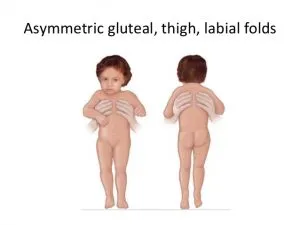One problem that happens to newborn or to infants in their earlier life is hip dysplasia. This condition is when the top part of the thigh bone does not secure to the hip socket. Parents should be aware of the following signs of hip dysplasia, in order to monitor their infants’ development. One sign is asymmetrical gluteal creases. Another sign is hip clicks, which can be checked through X-rays or ultrasound. There are two most reliable physical exam tests are Ortolani’s maneuver and Barlow’s test. These tests are designed to detect if hip is sliding in and out of the acetabulum. Also, limited range of motion and swaddling, or limping are also common signs of hip dysplasia. Limited range of motion refer to parents are having difficulty time to change diaper because the hips can not be fully spread.

To prevent hip dysplasia, parents can do a few things to help their infant baby. Wider car seats allow more room for babies to wiggle and move in the confide area. Second when using harnesses, thighs are supported at the knee joint. Finally, when using baby slings, it should support thighs and wide leg separation. Here are some things to keep in mind:



